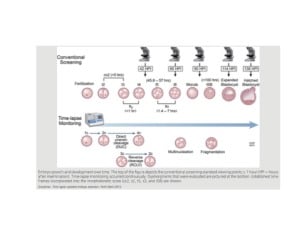We are experiencing a very high volume of calls and messages and ask for your patience. We will answer your portal messages within 48 hours.
We are experiencing a very high volume of calls and messages and ask for your patience. We will answer your portal messages within 48 hours.

 If you've ever wanted to know what happens in the embryology lab we've got a look at how new advances in the lab can help you on your journey to motherhood. The Embryoscope is a special incubator with a built-in microscope and high-definition camera allowing for continuous monitoring of embryonic development without culture disturbance for up to 72 embryos per scope. With assistance from image acquisition software, high-contrast static images can be obtained every 10 minutes from seven focal planes to create time-lapse videos. A very interesting Embryoscope video showing embryo development was presented in a previous blog.
If you've ever wanted to know what happens in the embryology lab we've got a look at how new advances in the lab can help you on your journey to motherhood. The Embryoscope is a special incubator with a built-in microscope and high-definition camera allowing for continuous monitoring of embryonic development without culture disturbance for up to 72 embryos per scope. With assistance from image acquisition software, high-contrast static images can be obtained every 10 minutes from seven focal planes to create time-lapse videos. A very interesting Embryoscope video showing embryo development was presented in a previous blog.
With its optics, the Embryoscope enables a detailed assessment of the early development of the embryos. It is now possible to assess appearance (morphology), as well as the timing of division of the cells (kinetics). Other factors that can be assessed include quality of the cells (multinucleation) and time to blastocyst formation.
Early studies showed a significant improvement in IVF success rates when the Embryoscope was compared to conventional culture conditions. However to date, it has not yet been established if adding the optical data to conventional embryo selection criteria improves clinical outcomes if all embryos are cultured in an Embryoscope without disturbance.
Goodman LR and her colleagues from the Cleveland Clinic in Beachwood, Ohio conducted a randomized controlled trial (Fertil Steril 2015, In Press) to answer this very question. Two hundred and thirty five patients undergoing IVF had their embryos cultured in an Embryoscope. Of these, 116 patients were randomized to conventional once-daily embryo screening with a microscope (CS) and 119 to additional time-lapse kinetic monitoring (TLM) for embryo selection. The results were interesting...

The clinical pregnancy rates (CPR) and implantation rates (IR) were similar overall (TLM vs. CS, respectively: CPR 68% vs. 63%; IR 51% vs. 45%) and with blastocyst transfers (CPR 74% vs. 67%; IR 56% vs. 51%). CPR with day 5 transfer was threefold higher than day 3 transfer, but group (TLM vs. CS) was not a significant predictor of clinical pregnancy or implantation. Significantly more multinucleation was detected when CS embryos were retrospectively reviewed with the use of TLM (7.0% vs. 35.3%), and multinucleation was independently associated with decreased rates of implantation. Time to the start of blastulation of <100 hours after insemination and the morphokinetic scoring system used in the TLM group were independently associated with implantation.
The authors concluded that the addition of the optical data did not significantly improve clinical reproductive outcomes in all patients and in those with blastocyst transfers.
Basically what this means is that the embryoscope is a fantastic tool for embryo culture. This is reflected in the excellent success rates reported by this group of researchers. The addition of the optical (time-lapse morphokinetic) data, does not further improve outcome.
At InVia Fertility Specialists, we have been using a culture system similar to the one used in the Embryoscope (Planar). We have not been using the optics to evaluate early embryo development. These data confirm that we are using optimal technology in our embryology laboratory and currently there is no need for change.
To see a fertility specialist who achieves excellent success rates using state-of-the-art technology, make an appointment at one of InVia Fertility’s four Chicagoland locations.

Entire Website © 2003 - 2020
Karande and Associates d/b/a InVia
Fertility Specialists
